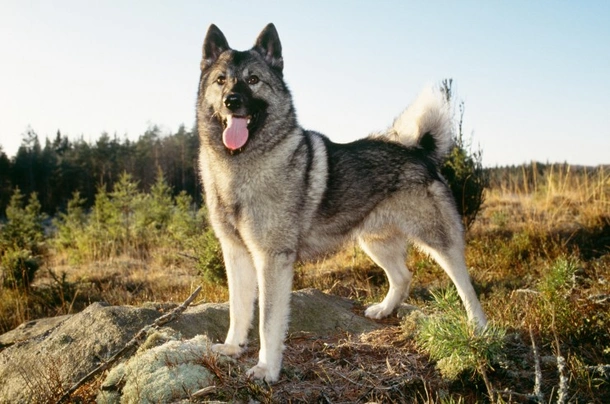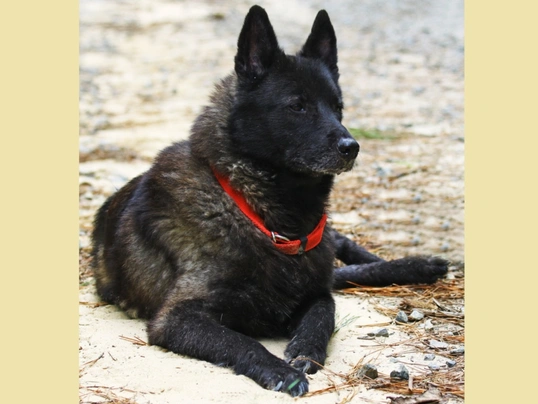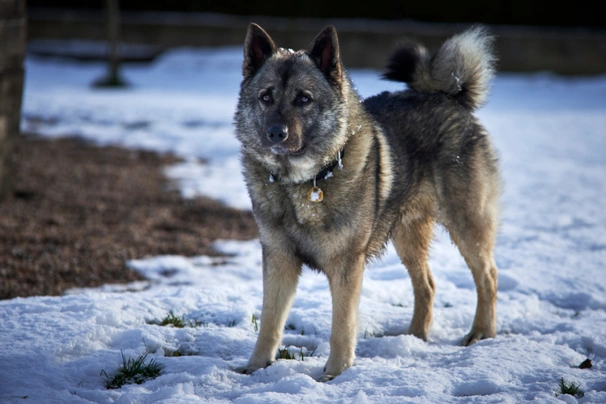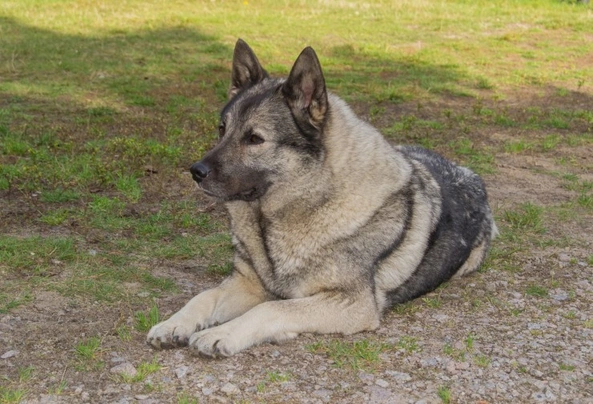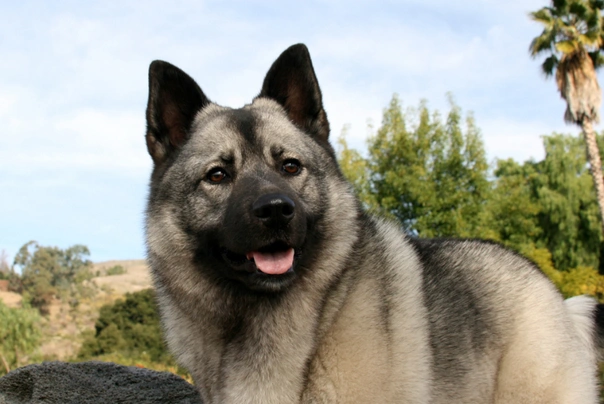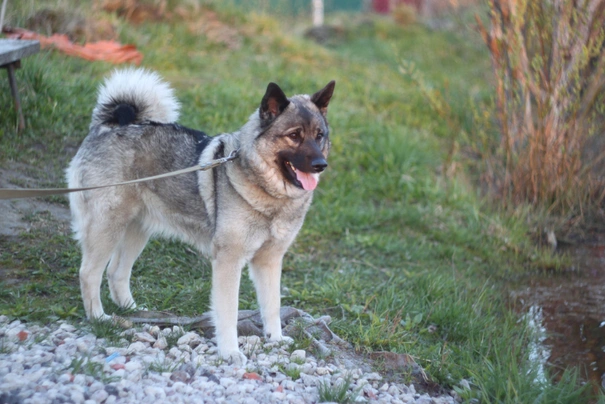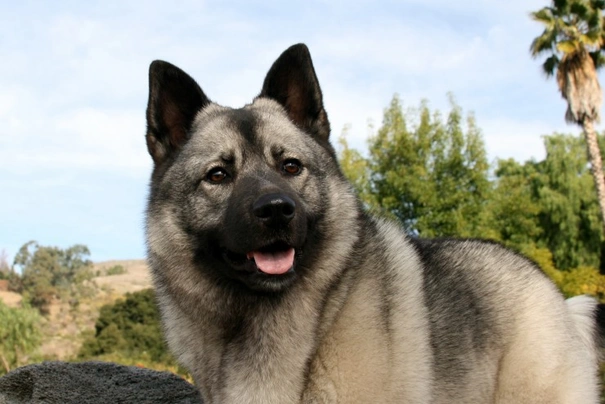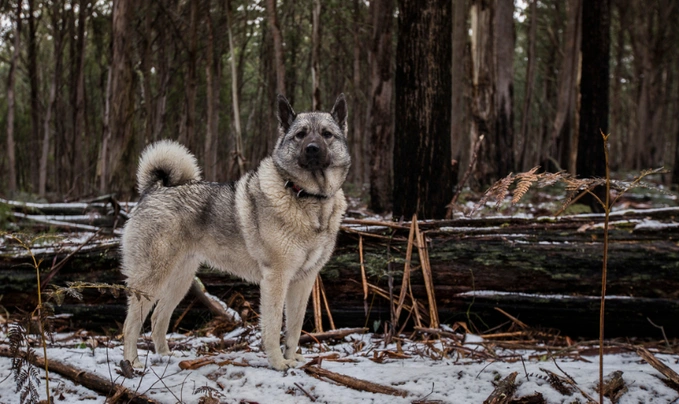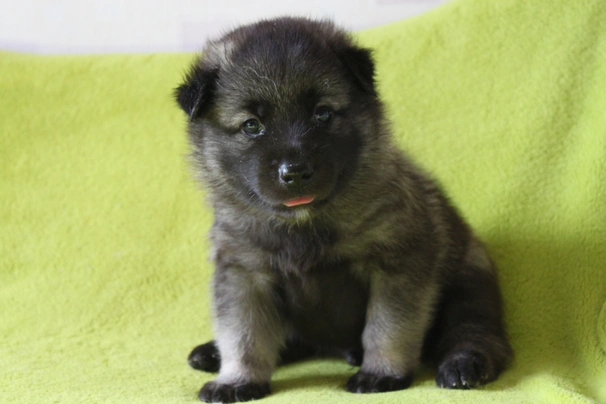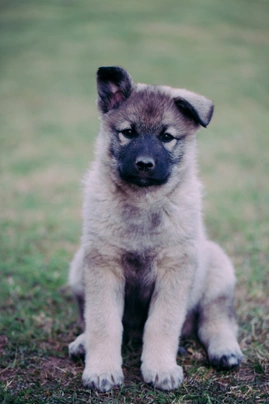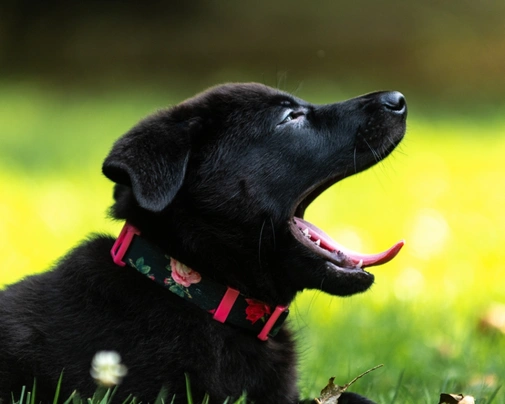Norwegian Elkhound
Pros
Cons
Introduction of the Norwegian Elkhound
The Norwegian Elkhound is a sturdy solid looking dog bred to hunt elk in Norway’s very northern regions. They are Spitz-type dogs with the same physical traits namely pricked ears and tight curly tails. They are highly prized in their native Norway not only for their stamina when hunting but also for their friendly and loyal natures which means they are wonderful family pets in a home environment.
Although not so well known here in the UK the Norwegian Elkhound is gaining a fan base thanks to their handsome looks and kind natures. However they are better suited to people who are familiar with the specific needs of this type of dog rather than novice owners because Norwegian Elkhounds are confident dominant and bold by nature.
History of the Norwegian Elkhound
The Norwegian Elkhound is thought to be an ancient breed with remains of very similar looking dogs having been discovered that date back to the Stone Age. These charming Spitz-type dogs originate from the very northern regions of Scandinavia where they were bred to hunt and guard livestock living alongside Vikings. They are highly skilled hunters being able to track their prey over great distances which includes larger animals like Elk. They are known to work just as well at night as they are during the day - a trait that made them highly prized by their owners.
In the mid 1800’s wolves were a real problem in Scandinavia which meant that livestock and people were often attacked. It was a time known as the “Wolf Period” in Norse folk tales. As such Elkhounds were not just hunting dogs but valuable guard dogs too and they wore spiked colours made of iron as extra protection against a wolf attack. There are many Nordic legends about Elkhounds and their bravery when confronted by a pack of wolves.
There are in fact two varieties of Elkhounds namely the Bandhund and the Loshund. A Bandhund tracks a scent and is held on a lead by a hunter whereas the Loshund goes ahead of the hunter so they can catch their prey. However Norwegian Elkhounds although highly prized throughout the ages in Scandinavia no records were kept until the late 19th Century. After this time many Elkhounds were exhibited not only in Scandinavian countries but in the United States and England too.
They were given their name Elkhound which translated from Norwegian means "moose dog" even though they were used to hunt smaller prey. Today they are still extremely popular in Scandinavia not only for their hunting and guarding skills but also because these charming dogs make wonderful companions and family pets thanks to their kind and calm natures. With this said anyone wishing to share a home with a Norwegian Elkhound would need to register their interest with breeders and agree to being put on a waiting list because few well-bred pedigree puppies are registered with The Kennel Club every year.
Interesting facts about the breed
- Is the Norwegian Elkhound a vulnerable breed? No they have a large fanbase in the UK and well-bred puppies can often command a lot of money because few Kennel Club registered puppies are available every year
- Elkhounds love the cold weather when there is lots of snow on the ground
- Elkhounds have existed for centuries with records of the breed being around in 5000 BC
- They should really be called “Moose Hounds”
- Norwegian Elkhounds make wonderful therapy and service dogs and they are formidable search and rescue dogs too
Appearance of the Norwegian Elkhound
Height at the withers: Males 49 - 52 cm Females 49 - 52 cm
Average weight: Males 22 - 25 kg Females 22 - 25 kg
Norwegian Elkhounds are stocky compact medium sized dogs that boast having quite a square outline. They have the typical pricked ears and tight curly tails typical of the Spitz and their coats can be a variety of shades of grey with a very distinctive stripe on their shoulders. They have wedge-shaped heads with a noticeable stop. The back of their heads and foreheads are a little arched but with no wrinkling. The bridge of their noses is straight and their eyes are medium in size and oval being a dark brown in colour. Norwegian Elkhounds always have a friendly courageous look about their eyes.
Their ears are small firm pointed and set high with dogs holding them upright. They have a strong jaw with a perfect scissor bite where their upper teeth neatly overlap their lower ones. Necks are moderately long and powerful with the hair on it being longer forming a ruff but with no dewlap. Their front legs are straight showing a good amount of bone and shoulders are powerful and sloping.
The Norwegian Elkhound has a powerful sturdy and compact body strong albeit short backs with their bellies being only very slightly tucked up. Chests are deep and broad with dogs having a nice curve to their ribs. Toplines are level and straight. Their hindquarters are strong and powerful with dogs have firm well-muscled back legs. Their feet are small and a little oval shaped with well arched tightly closed toes with quite a bit of hair in-between each of them. Nails are very strong. Their tails are set high and thickly covered in hair but no so much as it forms a plume. Dogs carry their tails tightly curled over their backs.
When it comes to their coat the Norwegian Elkhound boasts having a profuse close lying straight and coarse top coat and a much softer yet very dense and woolly undercoat that's extremely weather resistant. The hair on a dog's head and on the front of their legs is short and smooth whereas it is a little longer on the back of their legs. The hair on a dog's neck the backs of their thighs and tails is longer still. The accepted breed colours for Kennel Club registration are as follows:
- Grey
- Grey & Black
- Wolf Grey
It is worth noting that the accepted breed colours for Kennel Club registration can differ from those set out in the breed standard which are as follows:
- Various shades of grey with black tips to a dog’s outer coat chest stomach legs underside of a dog’s tail buttocks and harness mark is a lighter colour: a dog’s ears and face is dark and they have a dark line from their eyes to their ears. The undercoat is pure pale grey. Pronounced variations from a dog’s grey coloured coat or a sooty colour on their lower legs as well as spectacles or white markings are highly undesirable under the breed’s standard
Gait/movement
When a Norwegian Elkhound moves they do so with great purpose showing an effortless stride with their backs remaining level at the trot. As they get faster their front and back legs converge in straight lines under their bodies.
Faults
The Kennel Club frowns on any exaggerations or departures from the breed standard and would judge the faults on how much they affect a dog's overall health and wellbeing as well as their ability to perform.
Males should have both testicles fully descended into their scrotums and it is worth noting that a dog can be a little lighter or heavier as well as slightly taller or shorter than set out in the Kennel Club breed standard which is only given as a guideline.
Temperament of the Norwegian Elkhound
The Norwegian Elkhound is an energetic bold character and one that boasts being very intelligent although quite independent by nature. They are highly skilled hunters which means they have a high prey drive even when kept in a home environment. They make wonderful companions and family pets because they thrive in a home environment and being around people. They are also known to be quite extrovert and good natured although because they are so independent they can be a little stubborn at times which is a very Spitz-type trait.
Puppies need to be well socialised from a young age and this must include introducing them to lots of new situations noises people other animals and pets once they have been fully vaccinated which goes a long way in making sure they grow up to be more relaxed dogs wherever they are taken anywhere and meet other people and animals. Their training also must begin early bearing in mind that Norwegian Elkhounds are not known to be the most obedient dogs on the planet.
They can be a little over-protective of their families and property which is one of the reasons why early socialisation is so important for one of these high energy intelligent dogs. Norwegian Elkhounds need to know their place in the pack and who is the alpha dog in a household or they would quickly take on the role of dominant dog which can make them unruly and harder to live with.
They can be quite vocal at times which is another trait that needs to be gently curbed when a dog is still young. However a Norwegian Elkhound would always be quick to let an owner know when there are strangers about which means they make good watchdogs. They need to be handled and trained by people who are familiar with the particular needs of this type of dog. They are an ideal choice for people who live in more rural areas and in households where one person usually stays at home when everyone else is out of the house.
Because they are so intelligent a Norwegian Elkhound needs to be given the right amount of daily mental stimulation for them to be truly happy well-rounded dogs. Without enough to keep their minds busy dogs would quickly get bored which would prompt them to find ways of amusing themselves which could see them developing some unwanted and destructive behaviours around the home which is their way of relieving stress. All too often if they are left on their own for longer periods of time they develop separation anxiety simply because they love being around people so much and which is one of the reasons why they make such good PAT therapy dogs.
Are they a good choice for first time owners?
Norwegian Elkhounds are not a good choice for first time dog owners because they must be socialised handled and trained by people who are familiar with the needs of a high-energy intelligent active dog that can show a more dominant side to their natures if allowed. This can make living with an Elkhound that much harder.
What about prey drive?
Norwegian Elkhounds have a very strong prey drive and will happily ignore any commands to go off chasing anything they spot in the distance or animals that try to run away. As such care must be taken as to where when and if a dog can run off the lead. With this said it is must better to keep an Elkhound on the lead all the time just to be on the safe side.
What about playfulness?
Elkhounds have a very playful side to their natures and love to entertain and be entertained. They are known to be a little mischievous when the mood takes them and being so clever an Elkhound quickly learns how to open a cupboard door to get at any treats that might be in there. They also know what pleases an owner and use their silly antics to get their own way when the mood takes them.
What about adaptability?
Norwegian Elkhounds are better suited to people who have secure well-fenced back gardens can roam in whenever possible which allows a dog to let of steam and get rid of a lot of pent up energy. As such they are not well suited to living in an apartment.
What about separation anxiety?
Norwegian Elkhounds form strong ties with their families and dogs are never very happy when they find themselves left on their own for longer periods of time. They are better suited to people who either work from home or in households where one person stays at home when everyone else is out so they are never alone for any length of time which could see a dog suffering from separation anxiety. This can lead to them being destructive around the home which is a dog's way of relieving any stress they are feeling and a way to keep themselves entertained which could include incessant barking to get some attention.
What about excessive barking?
Elkhounds like the sound of their own voices a little too much which is something that needs to be gently nipped in the bud when a dog is still young being careful not to frighten them. With this said some owners say it is virtually impossible to prevent an Elkhound from voicing an opinion when they want to.
Do Norwegian Elkhounds like water?
Most Elkhounds love swimming and will take to the water whenever they can more especially when the weather is hot. However if anyone who owns a dog that does not like water should never force them to go in because it would just end up scaring them. With this said care should always be taken when walking an Elkhound off the lead anywhere near more dangerous watercourses just in case a dog decides to leap in and then needs rescuing because they cannot get out of the water on their own. It is also very important to thoroughly dry off an Elkhounds coat when they have been in the water to prevent any moisture from being trapped in the coats which could lead to an allergy flare up.
Are Norwegian Elkhounds good watchdogs?
Norwegian Elkhounds are always on the alert which means they are natural watchdogs although because they like to bark at anything it means they often sound the alarm for no real reason.
Intelligence / Trainability of the Norwegian Elkhound
Although the Elkhound is an intelligent dog and one that forms very strong bonds with their owners they can be quite difficult to train. Their education must start early with puppies being taught the "boundaries" as soon as they arrive in their new homes. With this said an Elkhound would always be ready to test these limits just to see how far they can go. As such their training must be consistent and always fair throughout a dog’s life.
Like many other hounds they are quite sensitive by nature which means they need to be handled with a very firm yet gentle hand. The key to keeping a dog focussed is to make their training sessions short fun and interesting. If the sessions are too long and too repetitive an Elkhound would soon get bored and loose interest making it that much harder to train them. It takes a lot of patience understanding and a good sense of humour to train an Elkhound which is just one of the reasons why they are not the best choice for novice owners.
Elkhound puppies like all puppies are incredibly cute and it is all too easy to spoil them when they first arrive in their new homes. However once a puppy is nicely settled new owners must start out as they mean to go on by laying down ground rules and boundaries. This helps a puppy understand what is expected of them and it also helps establish a “pecking order” and who the alpha dog is in a household. The first commands a puppy must be taught are as follows:
- Come
- Sit
- Stay
- Heel
- Quiet
- Leave it
- Down
- Bed
Children and other
If an Elkhound has grown up with children they get on extremely well together although playtime can get a bit boisterous especially when dogs are still young. As such any interaction between younger children and a dog should always be well supervised by an adult to make sure things stay calm and nobody gets too excited which could result in a toddler being knocked over albeit by accident.
When they are well socialised from a young enough age Elkhounds generally get on with other dogs they meet. However care must be taken when they are around smaller animals and pets which includes cats because their high prey drive would get the better of them with disastrous results therefore any contact is best avoided.
Health of the Norwegian Elkhound
The average life expectancy of a Norwegian Elkhound is between 12 and 15 years when properly cared for and fed an appropriate good quality diet to suit their ages.
Like many other breeds the Elkhound is known to suffer from a few hereditary health issues which are worth knowing about if you are planning share your home with one of these active handsome dogs. The conditions that seem to affect the breed the most include the following:
- Hip dysplasia – dogs must be hip scored through the BVA/KC hip dysplasia scheme
- Progressive retinal atrophy (PRA) – dogs must be eye tested through the BVA/KC eye scheme
- Renal dysplasia – dogs should be tested through the Breed Club
- Patellar luxation
- Fanconi syndrome
- Von Willebrand’s disease Type II
- Early retinal degeneration (ERD)
- Intracutaneous cornifying epithelioma
- Hot spots
- Sebaceous cysts
- Hypothyroidism
What about vaccinations?
Elkhound puppies would have been given their initial vaccinations before being sold but it is up to their new owners to make sure they have their follow-up shots in a timely manner with the vaccination schedule for puppies being as follows:
- 10 -12 weeks old bearing in mind that a puppy would not have full protection straight away but would be fully protected 2 weeks after they have had their second vaccination
There has been a lot of discussion about the need for dogs to have boosters. As such it's best to talk to a vet before making a final decision on whether a dog should continue to have annual vaccinations which are known as boosters.
What about spaying and neutering?
A lot of vets these days recommend waiting until dogs are slightly older before spaying and neutering them which means they are more mature before undergoing the procedures. As such they advise neutering males and spaying females when they are between the ages of 6 to 9 months old and sometimes even when a dog is 12 months old.
Other vets recommend spaying and neutering dogs when they are 6 months old but never any earlier unless for medical reasons. With this said many breeds are different and it is always advisable to discuss things with a vet and then follow their advice on when a dog should be spayed or neutered.
What about obesity problems?
Some Elkhounds can gain weight after they have been spayed or neutered and it's important to keep an eye on a dog's waistline just in case they do. If a dog starts to put on weight it's important to adjust their daily calorie intake and to up the amount of exercise they are given. Older dogs too are more prone to gaining weight and again it's essential they be fed and exercised accordingly because obesity can shorten a dog's life by several years. The reason being that it puts a lot of extra strain on a dog's internal organs including the heart which could prove fatal.
What about allergies?
Some Elkhounds are prone to suffering from a condition known as intracutaneous cornifying epithelioma which negatively impacts their hair follicles and hot spots too. It is important for a dog to see a vet sooner rather than later if one flares up. Allergies can be notoriously hard to clear up and finding the triggers can be challenging. With this said a vet would be able to make a dog with an allergy more comfortable while they try to find out the triggers which could include the following:
- Certain dog foods that contain high levels of cereals and other grain-type fillers
- Airborne pollens
- Dust mites
- Environment
- Flea and tick bites
- Chemicals found in everyday household cleaning products
Participating in health schemes
All responsible breeders would ensure that their stud dogs are tested for known hereditary and congenital health issues known to affect the breed by using the following schemes:
- BVA/KC hip dysplasia scheme
- DNA test for prcd-PRA
- Kidney test through Breed club
- Eye testing through the BVA/KC eye scheme
What about breed specific breeding restrictions?
Apart from the standard breeding restrictions that are in place for all Kennel Club registered breeds there are no other breed specific breeding restrictions in place for the
What about Assured Breeder Requirements?
It is mandatory for all Kennel Club Assured breeders to use the following tests on their dogs and all other breeders are strongly advised to follow suit:
The Kennel Club also strongly recommends that all breeders use the following tests on their dogs
Caring for the Norwegian Elkhound
As with any other breed Elkhounds need to be groomed on a regular basis to make sure their coats and skin are kept in top condition. They also need to be given regular daily exercise to ensure they remain fit and healthy. On top of this dogs need to be fed good quality food that meets all their nutritional needs throughout their lives.
Things you'll need for your puppy
There are certain items that new owners need to already have in the home prior to bringing a new puppy home. It's often a good idea to restrict how much space a puppy plays in more especially when you can't keep an eye on what they get up to bearing in mind that puppies are often quite boisterous which means investing in puppy gates or a large enough playpen that allows a puppy the room to express themselves while keeping them safe too. The items needed are therefore as follows:
- Good quality puppy or baby gates to fit on doors
- A good well-made playpen that's large enough for a puppy to play in so they can really express themselves as puppies like to do
- Lots of well-made toys which must include good quality chews suitable for puppies to gnaw on bearing in mind that a puppy will start teething anything from when they are 3 to 8 months old
- Good quality feed and water bowls which ideally should be ceramic rather than plastic or metal
- A grooming glove
- A slicker brush or soft bristle brush
- Dog specific toothpaste and a toothbrush
- Scissors with rounded ends
- Nail clippers
- Puppy shampoo and conditioner which must be specifically formulated for use on dogs
- A well-made dog collar or harness
- A couple of strong dog leads
- A well-made dog bed that's not too small or too big
- A well-made dog crate for use in the car and in the home that's large enough for a puppy to move around in
- Baby blankets to put in your puppy's crate and in their beds for when they want to nap or go to sleep at night
Grooming of the Norwegian Elkhound
The Norwegian Elkhound boasts having a double coat that consists of a harsher top coat and a much softer and very dense undercoat. They need to be brushed on a weekly basis to remove any dead and loose hair and to keep things tidy. They shed steadily throughout the year only more so during the Spring and then again in the Autumn when more frequent brushing is usually necessary to stay on top of things.
It's also important to check a dog's ears on a regular basis and to clean them when necessary. If too much wax builds up in a dog's ears it can lead to a painful infection which can be hard to clear up. In short prevention is often easier than cure when it comes to ear infections.
Exercise of the Norwegian Elkhound
The Norwegian Elkhound is a high energy intelligent dog and as such they need to be given the right amount of daily exercise and mental stimulation for them to be truly happy well-rounded dogs. They need anything from 40 to 60 minutes exercise a day with as much off the lead time as possible but only in a very safe and secure environment. If they are not given the right amount of mental stimulation and exercise every day an Elkhound would quickly get bored and could even begin to show some destructive behaviours around the home which is their way of relieving any stress they may be feeling.
A shorter walk in the morning would be fine but a longer more interesting one in the afternoon is a must. These dogs also like to be able to roam around a back garden as often as possible which allows an Elkhound to really let off steam. However the fencing must be extremely secure to keep these high energy dogs in because if they find a weakness in the fence they will soon escape out and get into all sorts of trouble bearing in mind that Elkhounds are very good escape artists.
With this said Elkhound puppies should not be over exercised because their joints and bones are still growing. This includes not letting a dog jump up and down from furniture or going up or down the stairs. Too much pressure placed on their joints and spines at an early age could result in a dog developing serious problems later in their lives.
Feeding of the Norwegian Elkhound
If you get a Norwegian Elkhound puppy from a breeder they would give you a feeding schedule and it's important to stick to the same routine feeding the same puppy food to avoid any tummy upsets. You can change a puppy's diet but this needs to be done very gradually always making sure they don't develop any digestive upsets and if they do it's best to put them back on their original diet and to discuss things with the vet before attempting to change it again.
Older dogs are not known to be fussy eaters but this does not mean they can be fed a lower quality diet. It's best to feed a mature dog twice a day once in the morning and then again in the evening making sure it's good quality food that meets all their nutritional requirements. It's also important that dogs be given the right amount of exercise to burn off any excess calories or they might gain too much weight which can lead to all sorts of health issues. Obesity can shorten a dog's life by several years so it's important to keep an eye on their waistline from the word go.
Feeding guide for a Norwegian Elkhound puppy
Puppies need to be fed a highly nutritious good quality diet for them to develop and grow as they should. As a rough guide an Elkhound puppy can be fed the following amounts every day making sure their meals are evenly spread out throughout the day and it's best to feed them 3 or 4 times a day:
- 2 months old - 170 g to 208 g depending on a puppy's build
- 3 months old - 196 g to 246 g depending on a puppy's build
- 4 months old - 207 g to 264 g depending on a puppy's build
- 6 months old - 209 g to 270 g depending on a puppy's build
- 7 months old - 191 g to 250 g depending on a puppy's build
- 8 months old - 173 g to 233 g depending on a puppy's build
- 10 months old - 156 g to 194 g depending on a puppy's build
- 11 months old - 154 g to 192 g depending on a puppy's build
When a puppy is 12 months old they can be fed adult food.
Feeding guide for an adult Norwegian Elkhound
Once fully mature an adult Norwegian Elkhound should be fed a good quality diet to ensure their continued good health. As a rough guide an adult Elkhound can be fed the following amounts every day:
- Dogs weighing 22 kg can be fed 234 g to 308 g depending on activity
- Dogs weighing 25 kg can be fed 253 g to 334 g depending on activity
Norwegian Elkhound price
If you are looking to buy a Norwegian Elkhound you would need to register your interest with breeders and agree to being put on a waiting list because very few puppies are bred and registered with The Kennel Club every year. You would need to pay anything upwards of £500 for a well-bred pedigree puppy. The cost of insuring a male 3-year-old Norwegian Elkhound in northern England would be £22.02 a month for basic cover but for a lifetime policy this would set you back £43.65 a month (quote as of April 2018). When insurance companies calculate a pet's premium they factor in several things which includes where you live in the UK a dog's age and whether they have been neutered or spayed among other things.
When it comes to food costs you need to buy the best quality food whether wet or dry making sure it suits the different stages of a dog’s life. This would set you back between £40 - £50 a month. On top this you need to factor in veterinary costs if you want to share your home with an Elkhound and this includes their initial vaccinations their annual boosters the cost of neutering or spaying a dog when the time is right and their yearly health checks all of which quickly adds up to over £1000 a year.
As a rough guide the average cost to keep and care for a Norwegian Elkhound would be between £50 to £100 a month depending on the level of insurance cover you opt to buy for your dog but this does not include the initial cost of buying a well-bred Kennel Club registered pedigree Norwegian Elkhound puppy.
Buying advice
When visiting and buying any puppy or dog there are many important things to consider and questions to ask of the breeder/seller. You can read our generic puppy/dog advice here which includes making sure you see the puppy with its mother and to verify that the dog has been wormed and microchipped.
Over the years Norwegian Elkhounds have found a large fanbase in the UK which means well-bred puppies can often command a lot of money. As such with Norwegian Elkhounds there is specific advice questions and protocols to follow when buying a puppy which are as follows:
- Beware of online scams and how to avoid them. You may see online and other adverts by scammers showing images of beautiful Norwegian Elkhoundpuppies for sale at very low prices. However the sellers ask buyers for money up front before agreeing to deliver a puppy to a new home. Potential buyers should never buy a puppy unseen and should never pay a deposit or any other money online to a seller. You should always visit the pet at the sellers home to confirm they are genuine and make a note of their address.
- As previously touched upon Norwegian Elkhounds are becoming a more popular breed as such many amateur breeders/people breed from a dam far too often to can make a quick profit without caring for the welfare of the puppies their dam or the breed in general. Under Kennel Club rules a dam can only produce 4 litters and she must be between a certain age to do so. Anyone wishing to buy an Elkhound puppy should think very carefully about who they purchase their puppy from and should always ask to see the relevant paperwork pertaining to a puppy's lineage their vaccinations and their microchipping

